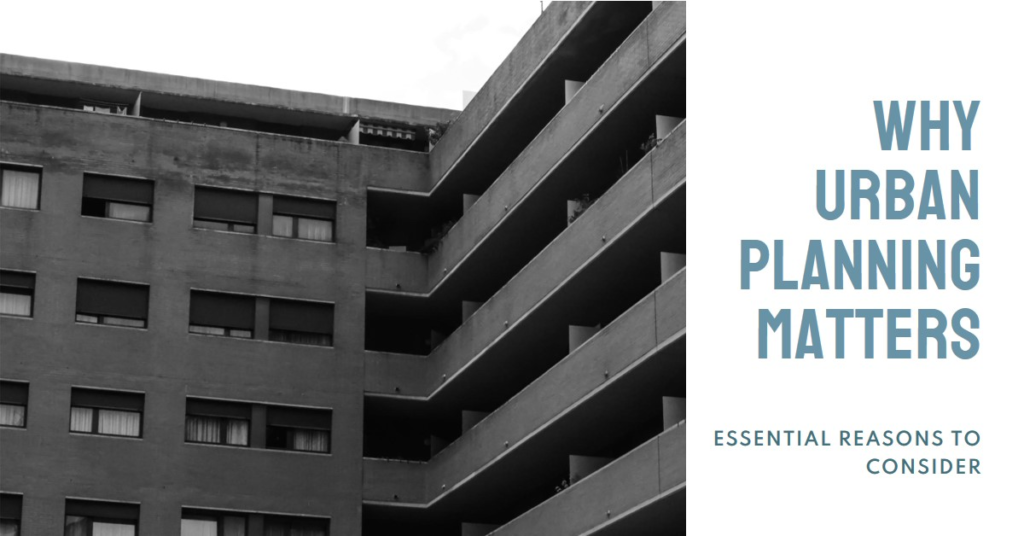
Table of Contents
- Introduction: The Heartbeat of Modern Cities
- Creating Livable Spaces: The Foundation of Well-being
- Ensuring Sustainable Development: Balancing Growth and Environment
- Enhancing Mobility and Accessibility: The Backbone of Urban Life
- Fostering Economic Growth: The Engine of Prosperity
- Promoting Social Equity: Building Inclusive Communities
- Preserving Cultural Heritage: Honoring the Past While Building the Future
- Enhancing Public Health: Designing for Well-being
- Improving Safety and Security: Protecting Citizens
- Conclusion: The Essential Role of Urban Planning
Introduction: The Heartbeat of Modern Cities
Urban planning is the silent force shaping our cities and communities, ensuring they are functional, sustainable, and livable. It encompasses a broad range of activities, from zoning laws and infrastructure development to public transportation and green spaces. In this blog post, we will delve into the essential reasons why urban planning is crucial, exploring its impacts on various aspects of city life.
Creating Livable Spaces: The Foundation of Well-being
One of the primary goals of urban planning is to create spaces where people can live comfortably and happily. This involves thoughtful zoning that separates residential areas from industrial zones, ensuring that citizens can enjoy peace and quiet at home without the disturbances of heavy industry. Moreover, urban planning integrates recreational areas, parks, and green spaces, which are vital for the mental and physical health of residents.
Furthermore, urban planning also ensures that essential services such as schools, hospitals, and supermarkets are within easy reach of all neighborhoods. By strategically placing these facilities, planners can help reduce the stress and inconvenience of long commutes, fostering a higher quality of life.
Ensuring Sustainable Development: Balancing Growth and Environment
Urban planning plays a crucial role in promoting sustainable development. By carefully managing land use, urban planners can help mitigate the environmental impact of urbanization. This includes preserving natural landscapes, reducing urban sprawl, and implementing green building practices.
In addition, urban planning promotes the use of renewable energy sources and energy-efficient designs. By encouraging the development of eco-friendly buildings and infrastructure, cities can reduce their carbon footprint and combat climate change. Moreover, urban planners work to ensure that cities are resilient to environmental challenges, such as flooding and extreme weather events, through strategic planning and infrastructure design.
Enhancing Mobility and Accessibility: The Backbone of Urban Life
Effective urban planning ensures that cities are easy to navigate, with efficient public transportation systems and well-designed road networks. This not only reduces traffic congestion and pollution but also improves the overall quality of life for residents.
By prioritizing public transportation, cycling, and walking paths, urban planners can create a more inclusive and accessible city. This not only benefits those who cannot afford private vehicles but also promotes healthier lifestyles and reduces the environmental impact of transportation.
Fostering Economic Growth: The Engine of Prosperity
Urban planning is instrumental in fostering economic growth and development. By creating a well-organized and efficient city layout, urban planners can attract businesses and investors, leading to job creation and economic prosperity.
Moreover, urban planning helps to revitalize declining areas and promote balanced regional development. By investing in infrastructure and public amenities, planners can attract new businesses and residents to underdeveloped areas, stimulating local economies and reducing disparities within the city.
Promoting Social Equity: Building Inclusive Communities
One of the most important aspects of urban planning is its focus on promoting social equity and inclusion. By ensuring that all residents have access to essential services and amenities, urban planners can help to reduce social inequalities and create more inclusive communities.
This includes designing public spaces that are accessible to all, regardless of age, ability, or socioeconomic status. Additionally, urban planning can help to address issues of affordable housing, ensuring that all residents have access to safe and affordable places to live.


Preserving Cultural Heritage: Honoring the Past While Building the Future
Urban planning also plays a crucial role in preserving cultural heritage and promoting a sense of community identity. By protecting historical landmarks and integrating them into the modern urban landscape, planners can help to maintain a city’s unique character and cultural heritage.
Moreover, urban planning can promote cultural diversity by supporting the development of cultural institutions and public spaces that celebrate different traditions and communities. This not only enriches the cultural life of the city but also fosters social cohesion and mutual understanding among residents.
Enhancing Public Health: Designing for Well-being
The design and layout of a city can have a significant impact on the health and well-being of its residents. Urban planning can help to promote public health by creating environments that encourage physical activity, reduce pollution, and provide access to healthy food.
This includes designing walkable neighborhoods, creating parks and recreational facilities, and ensuring access to healthcare services. By prioritizing public health in urban planning, cities can create healthier and more vibrant communities.
Improving Safety and Security: Protecting Citizens
Urban planning is essential for ensuring the safety and security of city residents. This involves designing cities that are resilient to natural disasters, such as earthquakes and floods, as well as man-made threats, such as crime and terrorism.
By implementing safety measures, such as building codes and zoning regulations, urban planners can help to protect residents and reduce the risk of disasters. Additionally, the design of public spaces can play a crucial role in promoting safety, with well-lit streets and public areas that encourage community engagement and deter criminal activity.
Conclusion: The Essential Role of Urban Planning
In conclusion, urban planning is a vital component of modern city life, impacting everything from the environment and economy to public health and social equity. By thoughtfully designing and managing urban spaces, planners can create cities that are not only functional and efficient but also sustainable, inclusive, and resilient. As we continue to face the challenges of rapid urbanization and climate change, the importance of urban planning will only continue to grow, shaping the cities of the future for the better.



